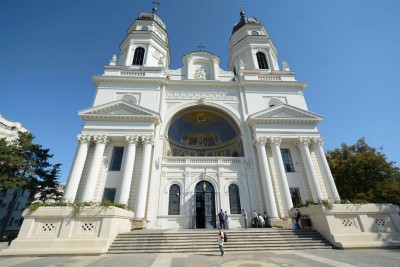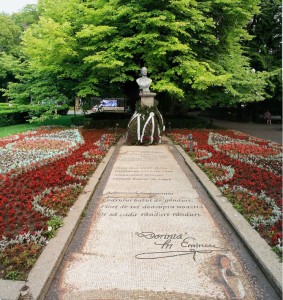“Iasi is more than a former illustrious capital of Moldavia, within its walls art and national historical treasures dwell, such abundant treasures that no other city in today’s Romania possesses,“ wrote historian Nicolae Iorga. For most cultures known as Iassy, the main urban center in Nord-Eastern Romania, a former capital of Moldavia and later of Romania, this is today’s third largest city in Romania and the second largest university and cultural center.
Deeply rooted in history, Iasi has been the main centre of Moldavian culture since 1408. The city prides itself with publishing the first Romanian newspaper and establishing the first Romanian university. Today, Iasi is home to five universities.
Each hill is populated with monuments, religious buildings, or parks:
- Cetățuia hill: Cetățuia Monastery (1668), Hlincea Monastery (1587), Frumoasa Monastery (1733);
- Galata hill: Galata Monastery (1582), Nicolina balneotherapy and well-being Centre;
- Copou hill: Podgoria Copou Monastery (1638), Iași Botanical Garden, Copou Park, Exhibition Park, and many monumental buildings;
- Breazu hill;
- Șorogari hill;
- Bucium hill: Bucium Monastery (1853), Bârnova Monastery (1628);
- Repedea hill: the Repedea Hill Fossil Site.
Touristic attractions to visit in Iasi
The Palace of Culture
The symbol of the city is the majestic Palace of Culture. Built in flamboyant Gothic Revival style, the palace has an amazing number of rooms - some 365, including the Gothic Room, which displays a medieval bestiary, the Voivoda Room, with portraits of the princes of Moldavia and the kings of Romania, and the beautiful Central Tower. Each hour eight bells in the tower play the ‘Union Dance’ song, which celebrates the creation of the United Principalities of Romania in the mid nineteenth century.
For over fifty years this extraordinary building has housed the bountiful National Museum Complex of Moldavia, which includes the History Museum, the Ethnography Museum, the Art Museum and the Museum of Science and Technology. A statue sits in front of the palace, which depicts Stephen the Great, Moldavia’s best-loved sovereign who lived at the end of the fifteenth century and is worshipped as a Saint of the Orthodox Church on 2nd July.
The churches
King Stephen, with great devotion, commissioned many places of worship, the oldest and most famous of which is the Royal Saint Nicholas Church, built at the end of the fifteenth century, which was situated near the royal court and served as the Metropolitan Cathedral. There are approximately 100 orthodox churches in the city. These include a new Cathedral, built in the nineteenth century in Italian Renaissance style, which houses the remains of Saint Parascheva, patron saint of Moldavia, and the Church of the Three Hierarchs (Basil the Great, John Chrysostom and Gregory of Nazianzus), built in the seventeenth century with a traditional Moldavian layout in the form of a clover leaf. This uniquely splendid building has rich oriental decorations of Byzantine inspiration and is known for its extraordinary stone lacery.
The Great Synagogue of Iasi is the oldest surviving Jewish prayer house in Romania and the second oldest synagogue in Europe. It was founded in 1670, reportedly at the initiative of Rabbi Nathan ben Moses Hannover, religious leader of Iasi's Jewish community in the 1660s. Since its foundation in the second half of the 17th century, the Great Synagogue has undergone a number of major renovations. Although called "the great," the size of the synagogue is actually very modest. Today, the Great Synagogue continues to serve the Jewish community of Iasi. It has been recognized as a historical monument.
The Copou garden
The Copou Garden was created in the first half of the nineteenth century on one of the seven hills on which Iasi is built, which range from a height of 40 to 400 metres above sea level. The largest park in the country, covering 80 hectares, it features a very old Romanian monument, the Obelisk of Lions, which was built to honour the European powers that recognised the independence of the Romanian principalities.
Vasile Alecsandri National Theatre
The fame of Iasi as a cultural centre is evident even in its entertainment sites, such as the spectacular Vasile Alecsandri National Theatre, dedicated to the great Romanian poet, writer and politician and one of the most active promoters of the theatre. The building, built approximately 100 years ago in Neoclassical style according to the project of Viennese architects, has a large auditorium housing 750 people and is furnished with Baroque and Rococo inspired decorations.
The museum celebrates the history of theatre in Iasi and displays costumes worn by well-known actors, original documents, playbills and posters.
Traditional foods
The city’s restaurants are very picturesque and offer traditional dishes of various origins, including simple but tasty oriental-inspired dishes made with an abundant use of spices. Typical dishes include Ciorba, a soup with potatoes and carrots, and pieces of lamb, veal and turkey, Sarmala, minced meat and onions wrapped in vine leaves, Mamaliga, a cornmeal porridge served with sour cream. A local sweet is Cozonac, which is similar to Italian panettone and filled with raisins. The wines, including the internationally renowned Negru de Purcari, together with the plum and apricot liqueurs, are excellent.
Source:romaniatourism.ro, aviontourism.com






